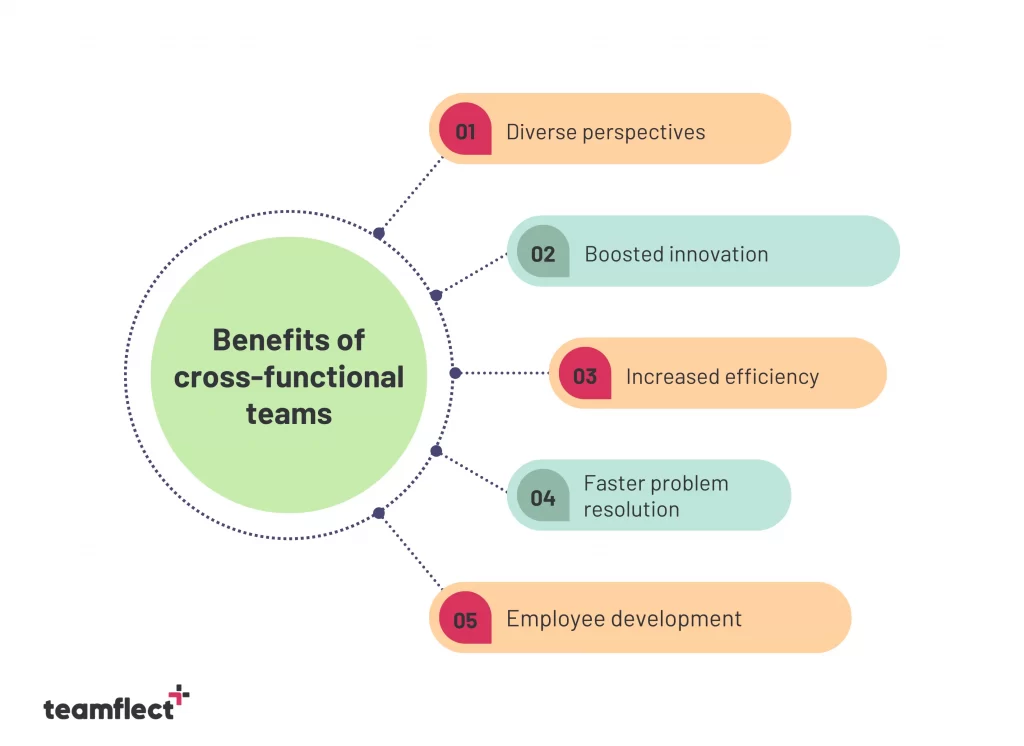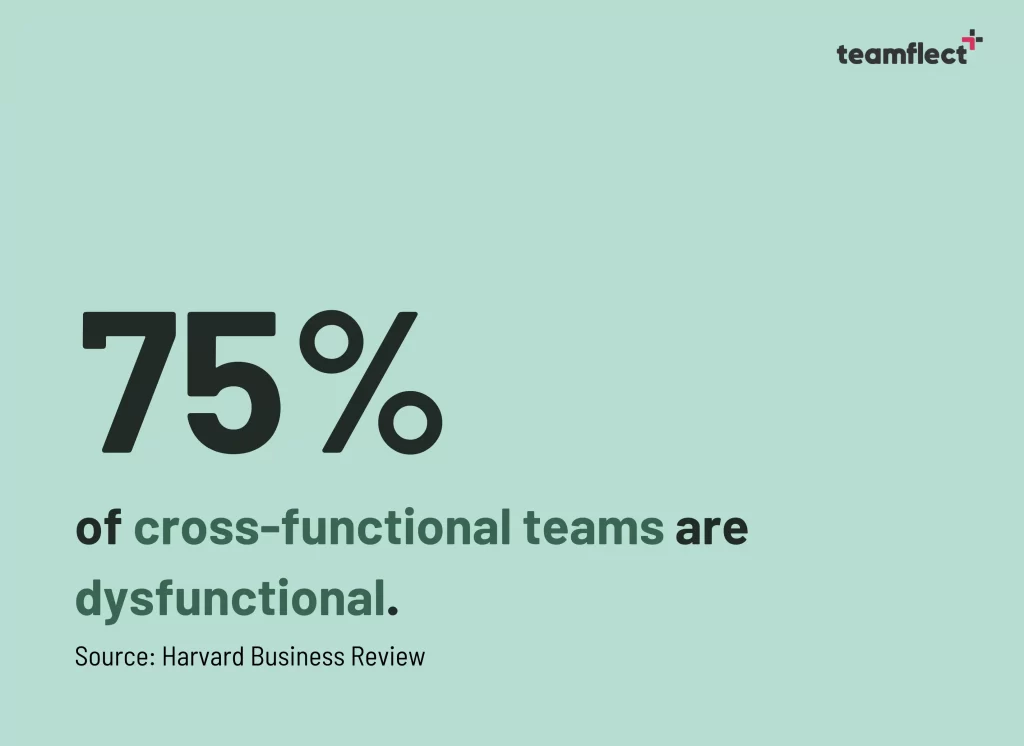If you ask us, sports analogies and performance management go hand in glove. Perhaps there is no greater topic than building cross-functional teams on that front. With the round of 16 in one of the most controversial world cups ever drawing to a close, we saw it fit to have a little discussion on building cross-functional teams.
Let’s face it. No matter how exciting the prospect might be to some fans, you can’t have eleven Ronaldos out on the pitch and expect a proper game. A team needs diversity like FIFA needs its brand sponsorships. The unique input from each member is what makes a well-built team a true force of nature.
Putting together a team presents leaders with an incredibly unique and extremely powerful opportunity. When building a cross-functional team or practicing cross-functional team leadership, people leaders have the amazing opportunity to create a unique combination of individuals with differing strengths and weaknesses.
While some of these combinations might end up as your run-of-the-mill teams, every once in a while you can end up with a cross-functional collaboration that has the potential to rock the organization it is a part of to its very foundations.
Table of Contents
Before We Start…
If you need another perspective on cross-functional team management and need a performance management software to help you, you’ve come to the right place!
Try the best task management software, Teamflect for a clean start on your performance management journey!
What Is A Cross-Functional Team?
A cross-functional team is a group of employees from different functional areas or departments within an organization who come together to work on a specific project, task, or goal. Cross-functional teams are often formed to address complex problems or tackle projects that require diverse expertise and perspectives.
Perhaps you had some bad experiences about cross-functional teams, just like group projects we did on high school where some people try to do everything by themselves whereas others don’t touch a single thing. But it’s up to you to decide where your cross-functional teams will stand.
Cross-functional teams could either act as the secret weapon you’re holding and help your organization thrive, or become a failure where any effective work becomes done.
Benefits Of Cross-Functional Teams
Cross-functional teams have several benefits when they are structured and managed effectively. By creating the perfect cross-functional teams, you can increase productivity, find innovative solutions, and boost conflict resolution.
But these are not all the benefits of having a cross-functional team! Let’s look at the other benefits in detail:
1. Cross-Functional Teams Include Diverse Expertise
Cross-functional teams bring together employees with different skills and expertise from various departments. Having more diversity in your teams will lead to a more comprehensive understanding of problems and opportunities, resulting in better decision-making and problem-solving.
Different departments excel at different skills, and the opportunity of using these valuable skills altogether is the main strength of cross-functional teams. For example, analytical thinking of your IT guy could create wonders when he works with your creative marketing manager.
2. Cross-Functional Teams Promote Innovation
The combination of diverse perspectives in one team creates room for innovative solutions. Team members from different backgrounds can generate fresh ideas and creative approaches that might not have emerged in a more siloed or departmental structure.
After working in a department for a while, we start to think alike with our team members. A sales rep thinks like a sales rep, but they can get inspired by the ideas that will rise from other departments.
3. Cross-Functioanl Teams Increase Efficiency
In regular organizations, a project is handled by a department, then moved onto another if needed. On the contrary, people from different backgrounds and skills will work collaboratively on projects in a cross-functional team.
Think about a brilliant marketing idea from your marketing department, only to be cut down after a negative feedback from the finance department. But if these departments are working together in the first place, you’ll lose no time and energy by working towards a dead-end.

4. Cross-Functional Teams Have Faster Problem Resolution
Because cross-functional teams have the right expertise on hand, they can respond quickly to issues and resolve problems without the need to escalate them to higher levels of management. You can solve any technical or administrative issue without needing long diplomatic processes.
5. Cross-Functional Teams Boost Employee Development
Team members on cross-functional teams have the opportunity to learn from colleagues in different departments, which can contribute to their professional growth and talent development. If you have individual development plans in your organization, cross-functional teams can be a great way to create a roadmap for your employees.
6. Cross-Functional Teams Have Better Conflict Resolution
Cross-functional teams provide a forum for addressing conflicts and differences of opinion constructively. When managed effectively, conflicts can lead to better decision outcomes and team cohesion.
Challenges Of Cross-Functional Teams
It most definitely is not always sunny when it comes to cross-functional teams. Just like everything else, cross-functional teams also have their downsides. In fact, according to Harvard Business Review’s article, 75% of cross-functional teams are dysfunctional! Luckily, we’re here to warn you about what can go wrong!
1. Communication Barriers
Differences in language, and communication styles between team members from different departments can lead to misunderstandings and miscommunication. It’s crucial to create clear communication channels and remind your employees to have open dialogue if you’re creating a cross-functional team.
2. Conflicting Priorities
In a cross-functional team, members may have conflicting priorities or commitments in their own departments, which can make it challenging to put time and effort to the cross-functional team’s objectives. Carefully use coordination and negotiation to resolve this potential issue.
3. Differing Goals and Objectives
Since all team members will have different goals and objectives based on their functional areas, you can feel some tension if you don’t align personal goals with the team’s overall mission. Clear alignment of objectives with organizatonal and team goals is essential in a cross-functional team.

4. Leadership Challenges
Cross-functional teams often require strong leadership to keep the team focused, resolve conflicts, and ensure accountability. It can be challenging to find the right leader who can balance the interests of various team members, but it’s not impossible!
5. Decision-Making Delays
While cross-functional teams can streamline decision-making, they may also cause delays if team members cannot reach a consensus or if there is a lack of clarity regarding decision authority.
And that brings us back to the leadership part. If your cross-functional team has a good leader, you got nothing to worry about!
4 Steps To Build The Best Cross-Functional Teams

1. Identify the people
The first step in building a successful cross-functional team is to identify the right people. It’s important to bring together people from different departments and disciplines who have different skills and perspectives. This will ensure that the team has the right mix of skills and knowledge to tackle the task at hand.
2. Create a cross-functional team structure
Once you’ve identified the right people, it’s important to create a team structure that works for everyone. This should include a clear understanding of roles and responsibilities, as well as a plan for communication and decision-making. It’s also important to ensure that everyone is aware of the team’s objectives and that they understand how their individual contributions will help to achieve them.
3. Give your cross-functional team the means to change the world
Quite possibly the most important part of the cross-functional team puzzle is presenting your team with the right tools and resources they need to succeed. This may include access to the right technology, training, and support.
Can you imagine building a team of all-star players and not giving them the right training equipment? What your cross-functional team can surely use is project management software. Members of your team should be able to set and track tasks, manage OKRs, and conduct one-on-one meetings within this software.
4. Encourage Open Communication
After establishing the team structure and giving that team the best tools for the job, it’s important to foster an environment of trust and collaboration. You can accomplish this by encouraging open communication and providing opportunities for team members to get to know each other.
If the software mentioned in the previous entry has some feedback and recognition capabilities, it is always a plus. Whether your cross-functional team is communicating face-to-face or through a communication tool such as Microsoft Teams, it is an absolute must for them to be able to exchange feedback. 360-degree feedback, just like cross-functional teams, has its roots in cross-department interactions and can be a huge asset in keeping communication lines open in these teams.
What Are The Characteristics Of A Cross-Functional Team?

A cross-functional team is a group of people from different departments and areas of expertise who come together to work on a specific project or task. This type of team is often used in organizations to increase efficiency and collaboration, as well as to help break down silos between departments.
The main characteristics of a cross-functional team are:
1. Diversity
A cross-functional team is composed of members from different departments and backgrounds, each bringing their own unique skills and perspectives to the table. This diversity of perspectives and skillsets can help the team come up with creative solutions to problems and increase the overall effectiveness of the team.
2. Collaboration
Cross-functional teams are designed to foster collaboration between members from different departments. This collaboration helps to break down silos between departments and encourages members to work together to achieve a common goal.
3. Flexibility
Cross-functional teams are often more flexible than traditional teams, as members can switch roles and tasks as needed. This flexibility allows the team to respond quickly to changes in the environment and adapt to new challenges.
4. Accountability
Cross-functional teams are held accountable for their performance, as each member is responsible for their own tasks and the overall success of the team. This accountability encourages members to take ownership of their work and strive to do their best.
5. Communication
Cross-functional teams rely on effective communication between members in order to be successful. This communication should be open and honest, and members should be encouraged to share their ideas and opinions.
Cross-functional teams can be an effective way to increase collaboration and efficiency in an organization. By bringing together members from different departments and backgrounds, a cross-functional team can come up with creative solutions to problems and increase the overall effectiveness of the team.
However, it is important to ensure that the team is structured properly and that members are held accountable for their performance. With the right structure and communication, a cross-functional team can be a powerful tool for any organization.
What Is The Difference Between Functional And Cross-Functional Teams?
A functional team is a group of people who specialize in a particular area of expertise and work together to achieve a common goal. These teams are typically organized around a specific function, such as marketing, finance, or engineering. The members of the team are experts in their respective fields and work together to complete tasks related to their areas of expertise.
Cross-functional teams, on the other hand, are composed of members from different functional areas who work together to achieve a common goal. These teams are often used when an organization needs to bring together different perspectives and skills to solve a problem or complete a project. Cross-functional teams are beneficial because they can bring together different points of view and skill sets to create innovative solutions.
The main difference between functional and cross-functional teams is the scope of their work. Functional teams are focused on a specific area of expertise and are responsible for completing tasks related to that area, while cross-functional teams are responsible for completing tasks that require the input of multiple functional areas.
Examples Of Cross-Functional Teams
Cross-functional teams are like Legos, you can use them to play according to the book, or be creative and have fun with them! We have some examples of cross-functional teams for you. You can use these examples to create your own cross-functional team and increase productivity in your organization.
- Product Development Team:
- Members: Engineers, designers, marketers, quality assurance specialists, product managers.
- Objective: Develop a new product or improve an existing one.
- Role: Each member contributes their expertise to design, develop, market, and improve the quality of the product.
- Marketing Campaign Team:
- Members: Marketing specialists, graphic designers, content writers, data analysts.
- Objective: Create and launch a marketing campaign to promote a product or service.
- Role: Team members collaborate to develop the campaign strategy, design visuals, create content, analyze data, and track campaign performance.
- Supply Chain Optimization Team:
- Members: Procurement specialists, logistics managers, data analysts, operations experts.
- Objective: Optimize the supply chain to reduce costs and improve efficiency.
- Role: Team members work together to analyze data, identify bottlenecks, and implement process improvements.
- New Market Expansion Team:
- Members: Sales representatives, market researchers, legal advisors, financial analysts.
- Objective: Expand the company’s presence into a new geographic market.
- Role: The team collaborates to assess market opportunities, navigate legal and regulatory requirements, and develop sales and marketing strategies for the new market.
- Customer Experience Improvement Team:
- Members: Customer service representatives, UX/UI designers, data analysts, product managers.
- Objective: Enhance the customer experience and address common pain points.
- Role: Team members collect and analyze customer feedback, propose design changes, and implement improvements to products or services.
- Research and Development Team:
- Members: Scientists, engineers, researchers, technicians.
- Objective: Conduct research to develop new technologies, products, or solutions.
- Role: Team members collaborate on experiments, data analysis, and innovation to advance the organization’s R&D efforts.
- Financial Performance Improvement Team:
- Members: Finance analysts, accountants, budget planners, strategists.
- Objective: Improve the company’s financial performance and profitability.
- Role: Team members assess financial data, identify cost-saving opportunities, and recommend strategic financial decisions.
- Cybersecurity Incident Response Team:
- Members: IT professionals, cybersecurity experts, legal advisors.
- Objective: Respond to and mitigate cybersecurity incidents.
- Role: Team members collaborate to identify security breaches, contain threats, investigate the incident, and implement security measures to prevent future attacks.
Conclusion
In conclusion, cross-functional teams can be a gift or a problem, depending on your approach. If you want to encourage innovation, creativity and productivity in your organization, you can try implementing cross-functional teams.
But remember that it’s not easy to create a well-structured team consisting of employees that have different professions and skills. You might need a companion for help along the way. Something like Teamflect, the perfect employee engagement tool. If you’re interested, why don’t you…




